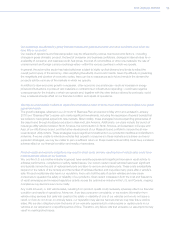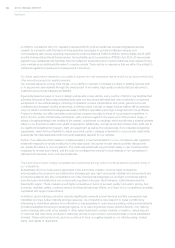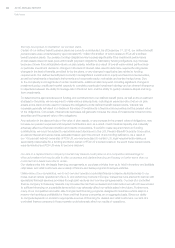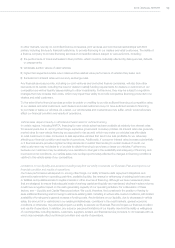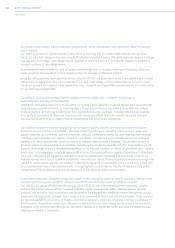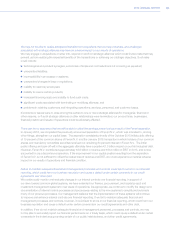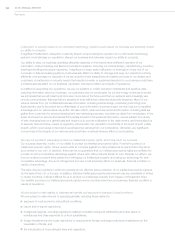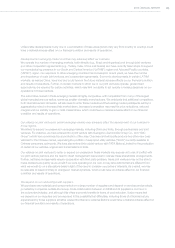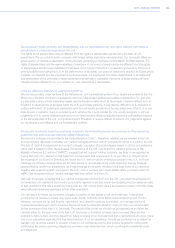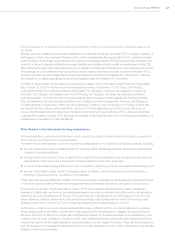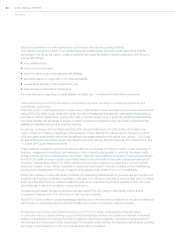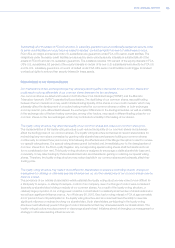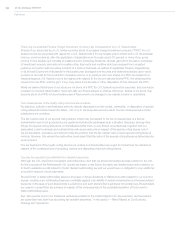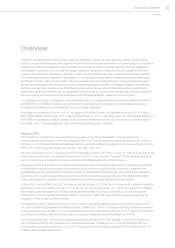Chrysler 2015 Annual Report Download - page 24
Download and view the complete annual report
Please find page 24 of the 2015 Chrysler annual report below. You can navigate through the pages in the report by either clicking on the pages listed below, or by using the keyword search tool below to find specific information within the annual report.
24 2015 | ANNUAL REPORT
Risk Factors
We face risks associated with increases in costs, disruptions of supply or shortages of raw materials, parts,
components and systems used in our vehicles.
We use a variety of raw materials in our business including steel, aluminum, lead, resin and copper, and precious
metals such as platinum, palladium and rhodium, as well as energy. The prices for these raw materials fluctuate, and
market conditions can affect our ability to manage our cost of sales over the short term. We may not be successful
in managing our exposure to these risks. Substantial increases in the prices for raw materials would increase our
operating costs and could reduce profitability if the increased costs cannot be offset by changes in vehicle prices or
countered by productivity gains. In particular, certain raw materials are sourced from a limited number of suppliers and
from a limited number of countries. We cannot guarantee that we will be able to maintain arrangements with these
suppliers that assure access to these raw materials, and in some cases this access may be affected by factors outside
of our control and the control of our suppliers. For instance, natural or man-made disasters or civil unrest may have
severe and unpredictable effects on the price of certain raw materials in the future.
As with raw materials, we are also at risk for supply disruption and shortages in parts and components for use in our
vehicles for many reasons including, but not limited to, tight credit markets or other financial distress, natural or man-
made disasters, or production difficulties. We will continue to work with suppliers to monitor potential disruptions and
shortages and to mitigate the effects of any emerging shortages on our production volumes and revenues. However,
there can be no assurances that these events will not have an adverse effect on our production in the future, and any
such effect may be material.
Any interruption in the supply or any increase in the cost of raw materials, parts, components and systems could
negatively impact our ability to achieve our vehicle sales objectives and profitability. Long-term interruptions in supply
of raw materials, parts, components and systems may result in a material impact on vehicle production, vehicle
sales objectives, and profitability. Cost increases which cannot be recouped through increases in vehicle prices, or
countered by productivity gains, may result in a material impact on our financial condition and/or results of operations.
Labor laws and collective bargaining agreements with our labor unions could impact our ability to increase the
efficiency of our operations.
Substantially all of our production employees are represented by trade unions, are covered by collective bargaining
agreements and/or are protected by applicable labor relations regulations that may restrict our ability to modify
operations and reduce costs quickly in response to changes in market conditions. These and other provisions in our
collective bargaining agreements may impede our ability to restructure our business successfully to compete more
effectively, especially with those automakers whose employees are not represented by trade unions or are subject to less
stringent regulations, which could have a material adverse effect on our financial condition and results of operations.
We are subject to risks associated with exchange rate fluctuations, interest rate changes, credit risk and other market risks.
We operate in numerous markets worldwide and are exposed to market risks stemming from fluctuations in currency
and interest rates. The exposure to currency risk is mainly linked to the differences in geographic distribution of our
manufacturing activities and commercial activities, resulting in cash flows from sales being denominated in currencies
different from those connected to purchases or production activities.
We use various forms of financing to cover funding requirements for our industrial activities and for providing financing
to our dealers and customers. Moreover, liquidity for industrial activities is also principally invested in variable-rate
or short-term financial instruments. Our financial services businesses normally operate a matching policy to offset
the impact of differences in rates of interest on the financed portfolio and related liabilities. Nevertheless, changes in
interest rates can affect Net revenues, finance costs and margins.
In addition, although we manage risks associated with fluctuations in currency and interest rates through financial
hedging instruments, fluctuations in currency or interest rates could have a material adverse effect on our financial
condition and results of operations.
Our financial services activities are also subject to the risk of insolvency of dealers and retail customers, as well as
unfavorable economic conditions in markets where these activities are carried out. Despite our efforts to mitigate such
risks through the credit approval policies applied to dealers and retail customers, there can be no assurances that we
will be able to successfully mitigate such risks, particularly with respect to a general change in economic conditions.



